The biggest buzz from Apple’s announcement yesterday was the launch of the Apple Watch, but the other hardware announcement will affect far more people: the new iPhone models.
There are two of them, called the iPhone 6 and the iPhone 6 Plus. But you can call them the Bigger iPhone and the Much Bigger iPhone.
And you’ll be able to order them starting Sept. 12, or buy them outright on the 19th. The watch won’t be available until next year.

The big iPhone 6 Plus (left), the slightly less big iPhone 6 (middle) both in black compared with a white iPhone 5s. (Siemond Chan/Yahoo Tech)
I’ll have a full review soon; in the meantime, here’s what I learned after trying out the phones in Apple’s demonstration building yesterday (the huge white temporary building that had mystified Apple followers earlier this week).

(Siemond Chan/Yahoo Tech)
Making big betterBoth phones follow roads paved by Samsung and other manufacturers, who are making both phones and screens bigger, as you can see here:
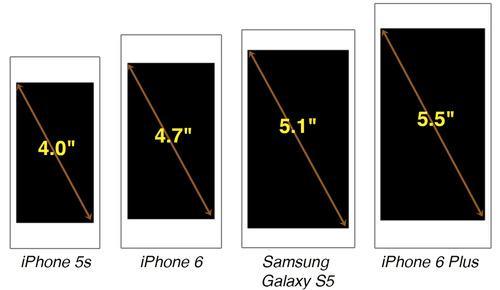
(David Pogue/Yahoo Tech)
In any mobile gadget, size is always a tradeoff: You want the biggest possible phone when you’re looking at it, but you want the smallest possible phone when you’re carrying it.
Apparently, the people have spoken, and they fall into the looker camp: The people want bigger. (Steve Jobs was in the other camp. Of larger phones, he said at a 2010 press event, “No one is going to buy them.”)
Which is kind of weird, since the general direction of gadget growth over generations is usually smaller. As someone on Reddit remarked: If the iPhone keeps getting bigger, and the iPad keeps getting smaller, pretty soon they’ll meet in the middle.
Anyway, Apple has done everything engineeringly possible to minimize the downsides of having a big phone. The sleep switch, for example, is now on the right edge, so you can get to it one-handed.
The Home screens, for the first time, now rotate with the phone:
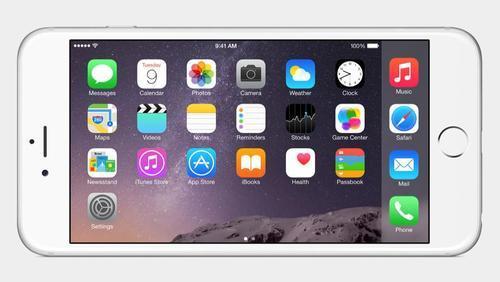 (Apple)
(Apple)And if there’s something you want to tap on the top part of the screen — too far away for your puny little thumb to reach — you touch the Home button twice (not fully click it). The iPhone screen image slides downward so that the top half of the image is now in thumb reach.
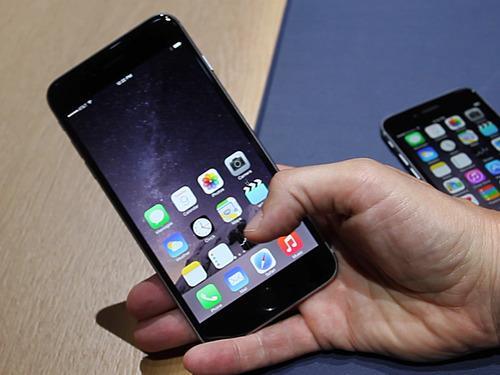 (Siemond Chan/Yahoo Tech)
(Siemond Chan/Yahoo Tech)(Samsung’s big phones offer something like this — they can crop the entire screen, putting black letterbox bars around the top and left sides, so that everything is within thumb reach. Here are the details.)
Finally, Apple made the phone really, really thin. Thinner than previous phones. Thinner than the Samsung Galaxies or LG’s G3. About a quarter of an inch thin.
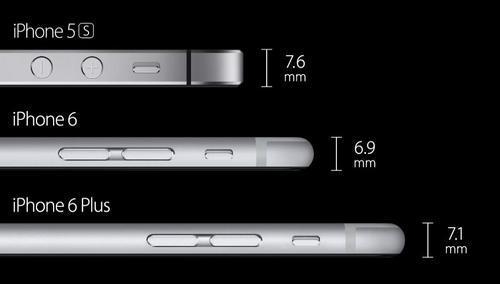 (Apple)
(Apple)Good thing it’s made out of aluminum; if it were anything less rigid, you could make a paper airplane out of it.
The edges are rounded, not sharp and square, for the first time in several iPhone models. It feels good. You’re tempted to rub your fingers over it as though it’s a worry stone. You can’t believe how little it weighs. And you can now tell which way the screen is facing in your pocket by touch, for the first time since the iPhone 3 family.
What’s insideThe new iPhones bring the usual annual improvements:
• A faster processor. Nobody’s exactly been complaining about the speed of current smartphones, but Apple says this chip is faster than ever. (50 percent faster at graphics tasks, 25 percent faster overall.)
• A better screen. Higher contrast, darker blacks, wider angle of view.
• Faster WiFi, faster cellular. According to Apple, anyway. And the phone works with VoLTE, a service that may soon be offered by your cellphone carrier, in which the other guy’s voice sounds super clear and close, like an FM radio.
• Free WiFi calling. Apple also says you can place calls when you’re in a WiFi zone, from your own phone number, to save a few cellular minutes.
• More storage. You can buy the new phones in 16-, 64-, and now 128-gigabyte versions. That oughta hold a few selfies. (Still no removable memory card, though, as on some rival phones.)
The prices are $200, $300, and $400 for those three models. Add $100 for the larger iPhone 6 Plus. Each is available in white, black, or gold. They go on sale Sept. 19.
Electronic paymentsThere were also a few surprises at the iPhone announcement. These new phones have an NFC chip (near-field communication), just like most Android phones have had for a while. NFC is something else Steve Jobs had resisted.
So now, yes, you’ll be able to use your iPhone to pay for things wirelessly — at stores with special terminals. Apple says that 220,000 stores are already equipped, and lots of big-name chains (like Macy’s, Bloomingdale’s, Whole Foods, McDonald’s, and Disney) are coming on board.
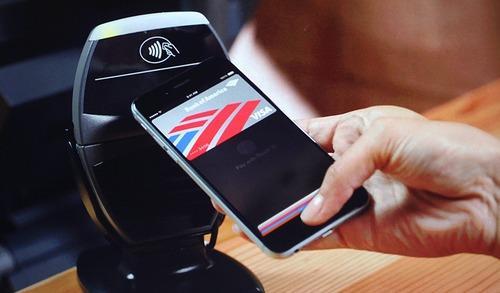 (Apple)
(Apple)Of course, Google has tried this phone-wallet concept already, and it hasn’t caught on. Apple thinks that it will do better — because the process will be much simpler and faster and because the security will be better: The fingerprint reader on the Home button confirms that you’re you and not someone who stole your phone, and also Apple says it will not know what you buy or where.
I’m aware that thousands of people are horrified by this concept. They fear privacy invasion, not to mention change (and I don’t mean coins back from the cashier). Well, fine; they’re under no obligation to use this system.
But younger people are generally much more comfortable with electronic convenience — and if this Apple Pay thing catches on, that’s exactly what they’ll get, in spades.
Big camera changes There’s a new sensor in the iPhone 6’s camera, and some really terrific new features.
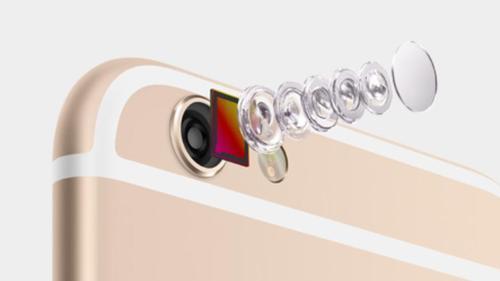 (Apple)
(Apple)The big one: Apple says it has managed to get phase detectionautofocusing in there. Here’s what that means:
Cameras these days have two ways to focus. Phones and most small cameras use contrast detection. They compare the image’s sharpness at two different lens positions. Unfortunately, that means they must “hunt” for sharp focus, moving the lens past the proper point and then backtracking. It takes time.
Professional cameras, like SLRs, usually focus using a more expensive method called phase detection. These cameras contain sensors that split incoming light into two beams and then compare them. Phase detection is usually faster, and better for moving subjects. In the iPhone, it means quick, precise refocusing whileyou’re shooting video.
Apple says the iPhone 6 is now the first phone in the world to have phase detection. I cannot wait to shoot with this thing.
The 6 Plus (but not the smaller model) also gains optical stabilization, again catching up to rival phones from Samsung and others. That is, the lens actually jiggles in precise motion to counteract the handheld movement of the phone itself, for fewer motion-blurred photos.
There’s also a new slow-motion video option: 240 frames per second, or one-eighth normal speed. And there’s a Hyperlapse-style time-lapse video option. (That, actually, is a feature of iOS 8, which you’ll be able to download Sept. 18 no matter which recent iPhone you have.)
The 6’s prospectsYou know what? I truly expected these bigger iPhones to feel too big. At the very least, I expected that it would take some time to get used to them.
But the iPhone 6 felt right and natural from the first moment I hefted it. The extra screen space does wonders for maps, email, ebooks, photos, movies, and webpages. In fact, the iPhone 5s feels a little claustrophobic once you return to it.
The iPhone 6 Plus is another story. It’s a monster. It’s like holding an iPad to your head. Heaven help you if you sit down with this thing in your back pocket.
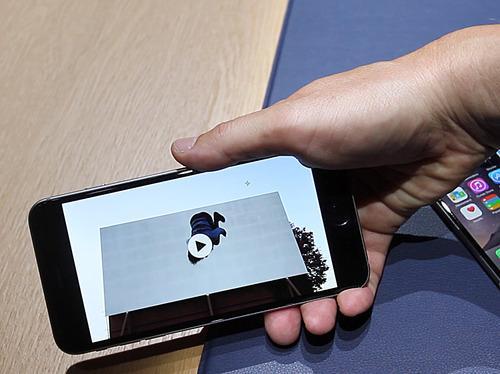 The size of the iPhone 6 Plus makes it great for viewing photos or videos. (Siemond Chan/Yahoo Tech)
The size of the iPhone 6 Plus makes it great for viewing photos or videos. (Siemond Chan/Yahoo Tech)Then again, people buy those mega-phones, so who am I to know?
In any case, it’s hard to think of a single area where the new iPhones aren’t better than the old ones — design, comfort, screen, speed, storage, camera, even battery (it’s slightly better than the old one) — as long as you don’t mind the bigger size.
The Android/iPhone religious war will certainly continue. Each of these ecosystems locks you in, making you grouchy about the opposing camp’s attractive features.
But if it’s too inflammatory to say that the iPhone 6 looks fantastic, let’s at least say this: Apple fans who’d been looking longingly at the big-screen progress in Android phones will no longer feel left behind.
No comments:
Post a Comment